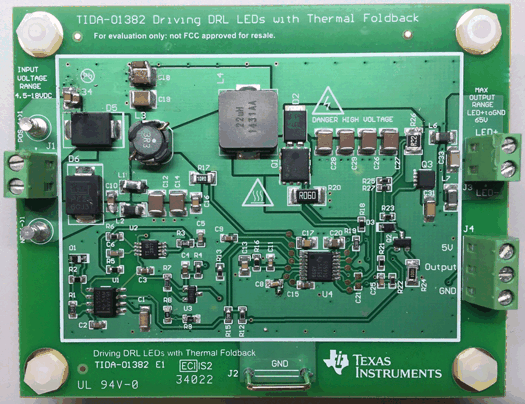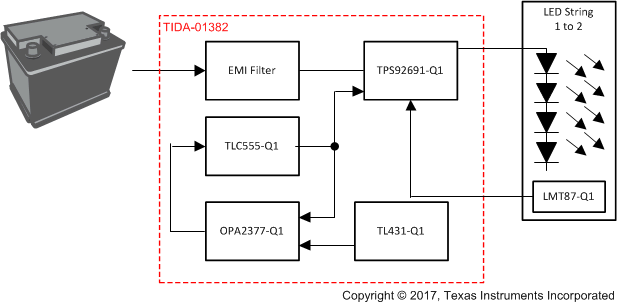-
Driving Daytime Running Lights LEDs With Thermal Foldback Reference Design
- 1 Overview
- 2 Resources
- 3 Features
- 4 Applications
- 5 Design Images
- 6 System Overview
-
7 System Design Theory
- 7.1 PCB and Form Factor
- 7.2 Optimizing Board Performance Based on LED String Voltage and Current
- 7.3 Switching Frequency
- 7.4 Output Overvoltage Protection (OVP)
- 7.5 Current Monitoring (IMON)
- 7.6 Thermal Foldback
- 7.7 Clock Generation (PWM)
- 7.8 Onboard Supply and Setting Duty Cycle
- 7.9 Buffering, Averaging, and Filtering
- 7.10 Boost Converter
- 8 Getting Started Hardware
- 9 Testing and Results
- 10Design Files
- 11Related Documentation
- 12About the Author
- IMPORTANT NOTICE
DESIGN GUIDE
Driving Daytime Running Lights LEDs With Thermal Foldback Reference Design
1 Overview
The TIDA-01382 implements thermal foldback for derating current through the LEDs without using a microcontroller. This TI Design uses the following devices: the TPS92691-Q1 multi-topology LED driver in boost configuration to control the LEDs, the TLC555-Q1 LinCMOS™ timer together with the OPA2377-Q1 operational amplifier to measure and generate the accurate PWM signal by applying a feedback loop and a precision shunt regulator for setting the accurate duty cycle, and the LMT87-Q1 to implement thermal foldback. The input and output stage of the design is EMI- and EMC-filtered and can be directly supplied by a car battery.
2 Resources
| TIDA-01382 | Design Folder |
| TPS92691-Q1 | Product Folder |
| LMT87-Q1 | Product Folder |
| TLC555-Q1 | Product Folder |
| OPA2377-Q1 | Product Folder |
| TL431A-Q1 | Product Folder |
3 Features
- Thermal Foldback
- Precision PWM Dimming
- Efficiency-Optimized Design
- Operation Through Cold Crank
- Load Dump Tolerant
4 Applications
- Automotive Front Lighting
- Automotive Daytime Running Lights
- Automotive Tail and Brake Lights

5 Design Images

 |
An IMPORTANT NOTICE at the end of this TI reference design addresses authorized use, intellectual property matters and other important disclaimers and information. |
